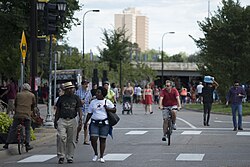Demographics of Minneapolis
The racial composition of the city is predominantly non-Hispanic White, making up approximately 58.1% of the population, followed by African Americans at 18.9%, and Asian at 5.8%.Economic factors also play a significant role in the demographic landscape, with a median household income of $58,993 as of 2020, and a poverty rate of 20.7%.[1] In its infancy, Minneapolis experienced rapid population growth due to industrialization, immigration, and the city's strategic location near the Mississippi River.Despite facing significant challenges such as the Great Depression, Minneapolis exhibited resilience, with its population growing to 464,356 by 1930 — an increase of 22.0%.The exodus to suburban areas was in part due to factors like "white flight," urban decay, and increased automobile ownership.Initiatives to rejuvenate downtown areas, improved public transportation, and an influx of younger professionals and immigrants contributed to this renewal.The city’s younger population has an estimated composition of 35% being non-Hispanic White, 32% Black, 17% Hispanic, 5% Asian, 2% Native American, 12% multiracial, and 9% of some other race.[10] Black residents began settling in Minneapolis as early as the late 19th century, particularly after the American Civil War, when northern cities were considered safer from the racial politics of the South.Originally consisting mainly of southern Chinese labor workers in the late 19th century, the city has since welcomed immigrants from Hong Kong, Taiwan, Japan, and Korea.[25] Regionally, the population is continuing to decentralize away from Minneapolis, relocating families and middle to upper income brackets outside the city.
United States Census BureauMinneapolisU.S. stateMinnesotacounty seatHennepin County2020 United States Censusnon-Hispanic WhiteAfrican AmericansHispanic or LatinosSomaliMississippi RiverGreat DepressionWorld War IIwhite flighturban decayautomobile ownershipDowntown MinneapolisMinneapolis–Saint Paul metropolitan areaAmerican Community SurveyBlack or African AmericanHispanic or LatinoPacific IslanderAmerican IndianAfrican AmericanNative Hawaiiantwo or more racesMexicoSomaliaEthiopiaVietnamCambodiaPacific Is.NativeOtherraceTwo or moreSpanishRussianAmharicChineseFrenchLanguageEnglishCushiteVietnameseGermanArabicLaotianJapaneseKoreanNorwegianItalianSwedishPolishMon-KhmerTagalogSwahiliKru, Ibo, YorubaUkrainianOjibwaSerbo-CroatianTibetanLettishPersianFinnishMandarinPortugueseDakotaTeluguBengaliHebrewTurkishFulaniCantoneseCroatianGujarathiFrench CreoleRomanianDanishNepaliBulgarianIndonesianIrish GaelicNiloticOther IndianSerbianHungarianYiddishMalayalamFormosanMarathiPashtoAfrikaansHocąkLithuanianmarried couplesHispanicsbachelor's degreespoverty linePew Research CenterChristiansProtestantRoman Catholicno religious affiliationJudaismBuddhismHinduismLutheranBlack ProtestantMethodistMormonEastern OrthodoxUS Census BureauWayback MachineDemographics of the United StatesAlabamaAlaskaArizonaArkansasCaliforniaColoradoConnecticutDelawareFloridaGeorgiaHawaii